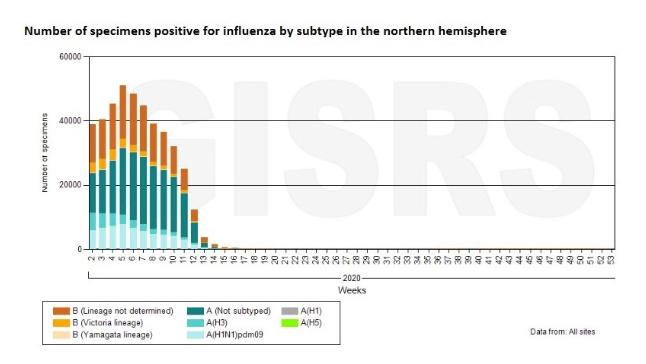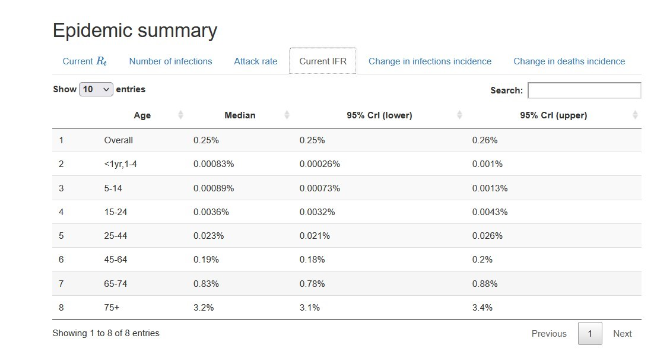Continuing Paul Weston’s series of articles intended for those who have not yet heard the truth about the disaster caused by the response to the Covid non-pandemic. You can read the introduction and Part 1 here. Click on the numbers for Parts 2, 3, 4, 5 and 6.
ACCORDING to the World Health Organization (WHO), flu mysteriously disappeared from the world in 2020. Actually, not quite all of 2020; it disappeared immediately after the Western governments initiated the Covid-19 lockdowns.

That is quite strange, isn’t it? Almost as though all the usual respiratory deaths caused by flu in every year other than 2020 were re-labelled as Covid-19 related respiratory deaths in 2020. An easy way of finding out if this was the case is to look at the Office for National Statistics respiratory death data for 2019 and 2020.
In 2019 there were 71,674 respiratory deaths. In 2020 there were 63,131 respiratory deaths. This is rather strange too, considering that the full name for Covid-19 is ‘Severe Acute Respiratory Syndrome Coronavirus 2′. I say strange, because it is most unusual – putting it mildly – to have a lower level of respiratory deaths during a supposedly apocalyptic pandemic driven by a virus which causes respiratory disease, no?
A death from influenza is medically the exact same as a death from Covid-19. It is a respiratory disease death. People die from an inability to breathe due to their lungs becoming congested with fluid, mucous, pus and blood. In reality, they die from viral pneumonia.
Influenza and Covid-19 cause pneumonia. No one dies directly from the flu or Covid-19; they die from the viral pneumonia caused by Covid-19 and influenza – the symptoms of which are identical from initial infection all the way through to pneumonia and possible death:
Stage 1: Cough/cold, feeling of heaviness in the chest, loss of appetite, fatigue;
Stage 2: Increase in cough intensity, shortness of breath, muscle aches, extreme fatigue, headaches, fever, chills, sweating, blue lips or nails due to lower blood oxygen levels;
Stage 3: Viral pneumonia, possible death.
The immune systems of healthy people can easily deal with flu or Covid-19 infections. You might feel terrible for a few days, but you soon get over it. Sadly, people with pre-existing serious illnesses (mostly old, but sometimes young) don’t have very good immune systems. Hence the large numbers who die in a bad flu year.
To sum up the above, influenza and Covid-19 both have the same symptoms, and both can lead to viral pneumonia and potential death. Especially so if left untreated. Is one more deadly than the other, though? Studying the infection fatality rates (IFR) for both diseases provides an answer to that question.
The IFR expresses in percentage form the number of people who die after being infected by a particular disease.
The IFR for influenza varies between 0.1 per cent and 0.2 per cent depending upon whether it is a good year or a bad year for flu. This equates to 1 death for every 1,000 people infected in a good year, and 2 deaths per 1,000 people infected in a bad year.
According to Cambridge University’s MRC Biostatistics Unit, the IFR for Covid-19 between April 2020 and November 2021 was 0.25 per cent, which is essentially an extremely bad year for flu. The original MRC Biostatistics Unit study is curiously no longer available on their site, but fortunately I saved it in December 2021 on the ingenious Wayback Machine Internet Archive site, from which I was able to grab the graph below.

It is a little hard to read, so I will re-write it below. The Covid-19 IFR statistics are as follows:
Age 1-4: 0.00083%
Age 5-14: 0.00089%
Age 15-24: 0.0036%
Age 25-44: 0.23%
Age 45-64: 0.19%
Age 65-74: 0.83%
Age 75-plus: 3.2%
The IFR for Covid-19 is an average of the seven sets of percentage figures above. It is heavily skewed by the 3.2 per cent amongst those aged 75 and over. But even when this group is included, the IFR is still only 0.25 per cent which is, as I say, not so very different from a particularly bad year for flu.
But we must bear something in mind here: most of the 75-year-olds and over who died in 2020 were victims of the Great Care Home Cull. They didn’t die from Covid-19 at all. They were in effect euthanised, yet their fraudulent Covid-19 death statistics play a hugely important part in skewing the IFR figures. If we disregard the 75+ age group, the IFR drops to 0.17 per cent, pretty much in line with influenza.
As we can see, Covid-19 presented no more threat of death than flu to those aged under 75. In point of fact, there is a greater risk to the young in falling over and breaking their necks than dying from Covid-19.
Conclusion: Influenza and Covid-19 have a similar infection fatality rate and similar symptoms. Both cause respiratory death via pneumonia. Respiratory deaths were broadly similar in 2020 and 2019. Somewhat mysteriously, they were slightly lower in the year of the pandemic. Influenza miraculously disappeared in 2020. Could such an unprecedented event (or non-event) be even remotely possible? Of course not. Flu deaths were simply re-labelled as Covid-19 deaths. Genius.
Tomorrow: How it started

